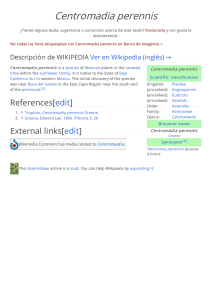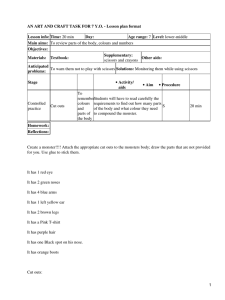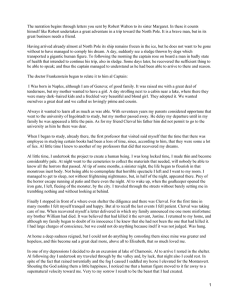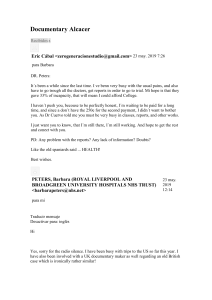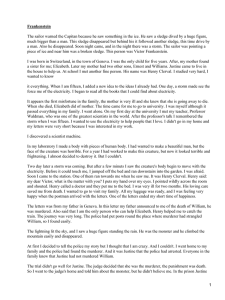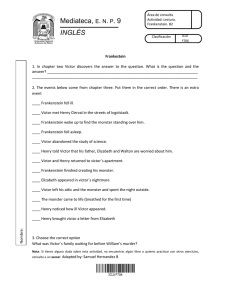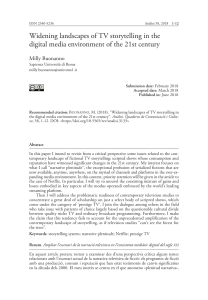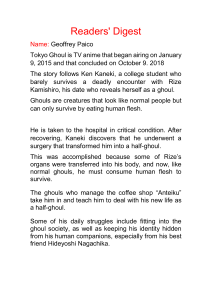Predator vs Prey: The Human Monstrosity in Attack on Titan
Anuncio
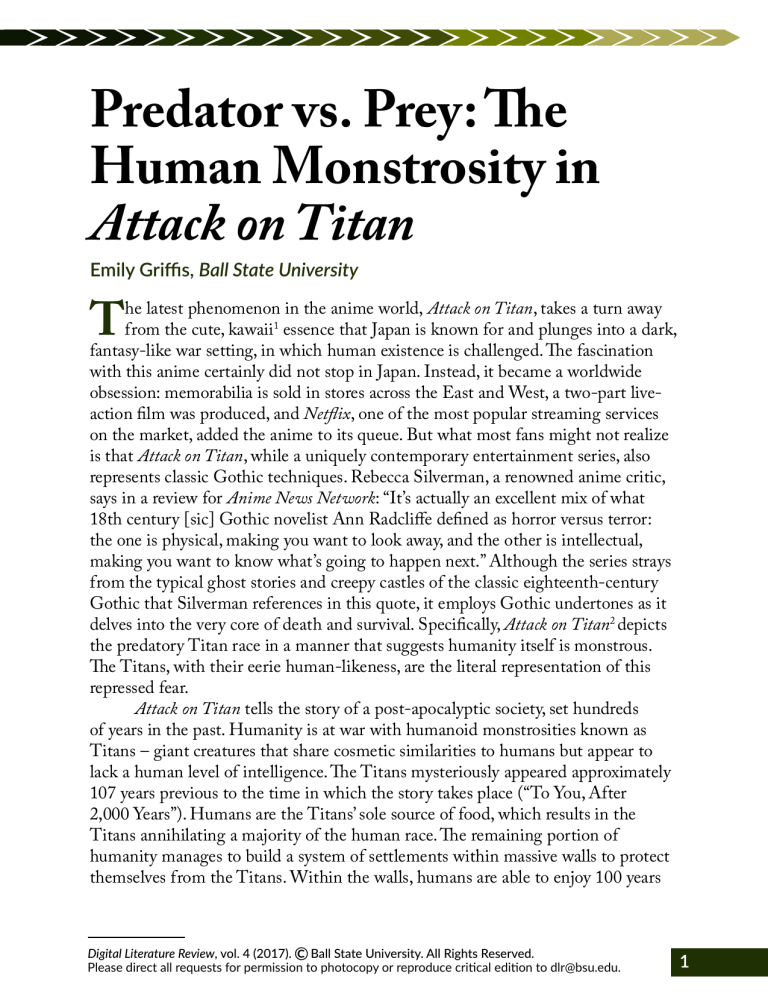
Predator vs. Prey: The Human Monstrosity in Attack on Titan Emily Griffis, Ball State University T he latest phenomenon in the anime world, Attack on Titan, takes a turn away from the cute, kawaii1 essence that Japan is known for and plunges into a dark, fantasy-like war setting, in which human existence is challenged. The fascination with this anime certainly did not stop in Japan. Instead, it became a worldwide obsession: memorabilia is sold in stores across the East and West, a two-part liveaction film was produced, and Netflix, one of the most popular streaming services on the market, added the anime to its queue. But what most fans might not realize is that Attack on Titan, while a uniquely contemporary entertainment series, also represents classic Gothic techniques. Rebecca Silverman, a renowned anime critic, says in a review for Anime News Network: “It’s actually an excellent mix of what 18th century [sic] Gothic novelist Ann Radcliffe defined as horror versus terror: the one is physical, making you want to look away, and the other is intellectual, making you want to know what’s going to happen next.” Although the series strays from the typical ghost stories and creepy castles of the classic eighteenth-century Gothic that Silverman references in this quote, it employs Gothic undertones as it delves into the very core of death and survival. Specifically, Attack on Titan2 depicts the predatory Titan race in a manner that suggests humanity itself is monstrous. The Titans, with their eerie human-likeness, are the literal representation of this repressed fear. Attack on Titan tells the story of a post-apocalyptic society, set hundreds of years in the past. Humanity is at war with humanoid monstrosities known as Titans – giant creatures that share cosmetic similarities to humans but appear to lack a human level of intelligence. The Titans mysteriously appeared approximately 107 years previous to the time in which the story takes place (“To You, After 2,000 Years”). Humans are the Titans’ sole source of food, which results in the Titans annihilating a majority of the human race. The remaining portion of humanity manages to build a system of settlements within massive walls to protect themselves from the Titans. Within the walls, humans are able to enjoy 100 years Digital Literature Review, vol. 4 (2017). Ball State University. All Rights Reserved. Please direct all requests for permission to photocopy or reproduce critical edition to [email protected]. 1 of peace until suddenly everything goes awry, and the first wall is infiltrated by Titans. The anime follows the story of Eren Yeager3 and his friends, Armin Arlert and Mikasa Ackerman, who are just children when their home, the Shiganshina District on the edge of the outer wall, is destroyed by Titans and evacuated. Eren says, “humanity was reminded that day of the terror of being at their mercy and the humiliation of being trapped inside a cage” (“Wall: Raid on Stohess”). The first episode of the series sets the tone surrounding a desperate society depleted by fear before it skips five years into the future: the Titans are on the move again, Eren and his friends have completed military4 training, and the divide between Titan and human blurs when Eren unknowingly reveals his ability to transform into one of the monstrous creatures. The divide becomes more muddled when the audience discovers that Annie, a soldier in Eren’s graduating class, can also transform into a Titan, and she works to destroy the human race from the inside. By the end of the season, the divide between human and Titan seems to shatter, leaving characters and audience questioning what it means to be human and how different Titans are from themselves. Although Attack on Titan is a series Silverman praises for its use of Gothic tropes, stating, “the violence is intense and the monsters are terrifying,” anime horror is unique from the Gothic form. Anime has created a sub-genre over time, which anime scholar Rayna Denison describes in a chapter of her book, titled Anime: A Critical Introduction, as “Body Horror,” involving grotesque transformations and mutations of the human body. The Titans are representative of this theory and work to challenge the societal boundaries and expectations of the culture they are present in, which makes them a perfect contemporary representation of the Gothic theory of monsters. In the first chapter of his book titled Monster Theory: Reading Culture, Jeffery Jerome Cohen develops seven theses on monster representations in the Gothic. Four of these theses can be applied directly to the Titans. Let us start with Cohen’s first thesis: the “monster’s body 1 Kawaii means “cute” in Japanese, but it is also used to refer to a segment of Japanese culture that celebrates “cuteness.” The Kawaii culture swept the nation with characters, such as Hello Kitty and Rilakkuma, led to the rise of maid cafes and cat cafes and became so well-known that Disney World’s Epcot featured an exhibit on it in Japan’s pavilion. You can see a virtual tour of Japan’s exhibit here: https://www.youtube. com/watch?v=lFuntOKQpXo. 2 Please note: this study focuses solely on the anime of Attack on Titan and only includes the story as told in Funimation’s adaptation. The manga series was not referenced for this paper. Citations attributed to the anime are based on the Netflix translation, and it is important to note that exact quotes may differ in other translations. 3 Depending on the translation, “Yeager” is also spelled “Jeager.” 4 The military is structured in three subcategories: the Military Police Brigade is the most coveted branch for its safe location positioned within the walls; the Survey Corps conducts missions outside the walls and comes into contact with Titans more often than the other branches, and the Garrison Regiment works between the two, keeping order within the walls and confronting Titans when required. Griffis 2 is a cultural body” (Cohen 4). Attack on Titan is a Japanese creation and must be evaluated for what the existence of Titans might say about the country’s repressed communal fears. Cohen states “the monster is born . . . as an embodiment of a certain cultural moment–of a time, a feeling, and a place” (4). Attack on Titan specifically elicits fear and a thirst for survival. Cohen’s theory suggests that the fears and upsets present in Attack on Titan were created by and within Japan’s post-war culture. Denison has her own idea that nearly matches Cohen’s theory but addresses the genre of anime more specifically. She states that “anime horror, by extension, is . . . linked to traditions within Japanese culture as a means of explaining the overt sense of cultural difference” (155). Both theories seem to suggest that most anime is created based on a time, event, place, or communal difference associated with Japan. Given Attack on Titan’s war plot and the feeling of impending doom for the human race, many scholars have linked this particular anime to World War II, specifically the bombing of Hiroshima. But what most scholars have not explored is the idea that the humans can be either the victim or the opposition. Thus, the Titans can also be placed in both roles: the attacked and the attacker. Let us start by considering Titans as representative of the bombs, or the opposition itself, which means the struggling human race featured in the series may be synonymous to the victims in the city of Hiroshima. This particular reading makes the anime unique. We are accustomed to hearing history recounted from the victor, but Attack on Titan is told through the eyes of the defeated. In her article, titled “What Does ‘Attack on Titan’ Really Mean?,” published at The Artifice, Sara Roncero-Mendez writes, “Titans, in this light, can be viewed as the enemy occupation, who are stronger and more well-equipped than humans, who consume their lives for no good reason – not for hunger (need of resources) but for the seemingly mindless consumption of a people hopelessly outmatched.” Regarding the Titans as the enemy in a setting similar to the bombing of Hiroshima prompts the audience to evaluate their own monstrous tendencies in the act of war by looking through the eyes of the attacked, rather than the attacker. This is even more influential if we consider how popular the series has become in the United States. However, if we allow Titans and humans to switch roles, naming Titans as the victims of Hiroshima post-bombing and humanity as the opposition, the dynamic shifts. G.E. Gallas, a writer and scholar of cross-cultural storytelling, writes in a blog post that the Titans’ excessively high-temperature bodies, which give off steam as they heal themselves, might be a parallel to how the bombed victims’ skin “melted off ” from the radiation. The main issue with this theory, one that many tend to actively resist, is that considering Titans as victims calls Griffis 3 for sympathy from the audience. But if we attempt to visualize the Titans as the Japanese nation, as Gallas suggests, we must consider the act that initially led to the bombing of Hiroshima; many think it was the United States revenge for Japan’s attack on Pearl Harbor. In this case, that means the hunted versus hunter dynamic in Attack on Titan is actually the exploration of what it means to be the bombed versus the bomber. The humans in the anime are the Titans’ prey, but humans are also the Titans’ predators, in the same way that Japan was both enemy of and victim to the U.S. In the anime, Jean5, a fellow soldier, says “If he [Eren] wipes out the Titans by turning into a monster like that, is that really a victory for humankind?” (“Wall: Raid on Stohess”). Jean effectively names revenge as a monstrous quality. The commander of the Garrison Regiment, General Dot Pyxis6, comments, “If humankind perishes, it won’t be because Titans devoured us. We will perish because we annihilated one another” (“Icon: Battle of Trost”). While there is speculation surrounding both of these theories, Cohen makes it clear that “the monster signifies the gap between the time of upheaval that created it and the moment into which it is received, to be born again” (4). The Titans are created around sixty-five years post-bombing, which suggests that Japan is still attempting to recreate the sense of national identity that it lost in the aftermath. Attack on Titan narrates this with the lack of racial representation in the series. In fact, it is explained that most races were wiped out when the Titans first appeared, which accounts for the lack of African, Indian, or Asian characters, among others (“The World She Saw”). Most characters are European, and due to the wild success of the series, fans around the world have attempted to trace the ethnicity of different characters. Based on names and appearances, twelve of the fifteen main characters are thought to be German (Al-Ani) while Mikasa is known as the last character of Asian descent left in the world (“The World She Saw”). It is significant that Mikasa is the only surviving Asian in a world dominated by the white race, since Japan would have felt alone and secluded after the Hiroshima bombing. But it is also significant that most of the Caucasians in the show are thought to be German. Germany was one of Japan’s allies in WWII. The bond between the two countries solidifies the relationship between Mikasa and Eren. As a child, Mikasa’s parents were murdered before she was kidnapped and forced to be sex slave (“The World She Saw”). Eren rescues her, murders her capturers, and accepts her as a surrogate sister (“The World She Saw”). Since that day, the two share a bond that prompts them to fight for and protect one another. 5 6 Griffis Depending on the translation, “Jean” is also known as “John.” Depending on the translation, “Pyxis” is also “Pixis.” 4 There are multiple times in the anime in which Mikasa or Eren fail to save each other. Their relationship is indicative of Japan’s struggle to regain a cultural identity among failed allies post-bombing. The Titans are not just monsters manifested from a cultural fear but also monsters that can be representative of fears worldwide, and the rest of Cohen’s theses explore this theory, starting with his second: the “monster always escapes” (4). This theory can be applied to the Titans in two different ways; the first is their implied immortality. Titans are so formidable because they are nearly impossible to kill. Cohen states, “No monster tastes of death but once,” and the Titans are no exception (5). They “completely ignore all other lifeforms” (“First Battle”) and show no interest in livestock or wildlife, but since they were able to survive 100 years without feeding on humans, it is determined that they don’t need to eat, drink, or even breathe to survive (“Special Operations Squad”). This is further supported when it is discovered “they don’t have a digestive track, so once they’ve eaten their fill of humans, they vomit them out” (“Primal Desires”). The only known way to kill the monsters is to do severe damage to the napes of their necks (“First Battle”). The soldiers are trained to take slices out of the neck at a certain depth and size with special flesh-slicing blades, but coming so close to the Titans’ mouths is almost never worth the risk and results in many soldiers’ deaths. With no other weaknesses, the Titans tower over the humans with insurmountable power. As Cohen suggests, they always escape, and they always come out ahead (4). The other, simpler way of viewing Cohen’s second thesis lays in the Colossal, Armored, and Female Titans. All three of these Titans are unique and separate from normal Titans. They are all skinless, intelligent, and unbelievably strong. After Eren shows intelligence and unusual strength as a Titan, it’s speculated that all three special Titans are also humans in a monstrous form (“Female Titan: 57th Expedition”). Cohen believes, “We see the damage that the monster wreaks, the material remains, but the monster itself turns immaterial and vanishes, to reappear someplace else” (4). This is important in the case of these three special Titans because each of them exhibits intelligence and war strategy equal to or greater than that of the human race. Each of these three Titans help the rest of the mindless Titan race reach the human population. For example, normal Titans are not able to breach the walls erected around the human settlements, but the Colossal and Armored Titans destroy them and then disappear (“To You, After 2000 Years”). Next is Cohen’s sixth thesis: “fear of the monster is really a kind of desire” (14). While monsters are dangerous and feared, they might also “evoke escapist fantasies” (Cohen 14-15). The humans in Attack on Titan harbor an unfathomable hatred for the Titans, especially the unknown Colossal and Armored Titans, but Griffis 5 we must question whether this hatred is manifested by the pain they cause or the power and strength they hold compared to human vulnerability. “We distrust and loathe the monster at the same time we envy its freedom,” Cohen explains (15). This rings true in Eren’s character, who exclaims that “anyone who’s seen the outside will have achieved the greatest freedom in the world” (“Primal Desires”). He either envies the Titans for making the outside their home or despises them for preventing him from doing the same. Their desire for the Titans’ strength might reflect humanity’s mindless desire to be able to control nearly everything that happens to them and others, as well as the monstrous techniques used to achieve this goal as a way to compensate for their physical weakness. However, out of all seven theses, the fifth, that the “monster polices the borders of the possible,” is the most applicable to the situation narrated in Attack on Titan (Cohen 12). As mentioned above, the remaining portion of humanity has enclosed themselves within walls in order to survive. The system consists of three different walls; the outer wall is known as Wall Maria, which falls to the Titans at the beginning of the series. The second layer is Wall Rose, which is evacuated after a second Titan attack later in the series, and the innermost wall, the most coveted location, is known as Wall Sina and serves as a home for the rich and noble. Cohen theorizes that “the monster prevents mobility, delimiting the social spaces through which private bodies may move . . . . To step outside this official geography is to risk attack by some monstrous border patrol or to become monstrous oneself ” (12). The Titans are a literal representation of keeping humanity within walls, limiting the geographical area that they can populate, and they continue to limit it each time the Titans attack because a wall must be evacuated. The citizens find themselves working to keep each other inside the walls, even after a century of peace. Thus, the boundary limits set by the Titans are enforced by the humans themselves. For example, when the Survey Corps returns from an unsuccessful mission, a bystander comments “that’s what they get for going outside the walls” (“The Defeated: 57th Expedition”). The walls start to become not just a necessity for survival but a sense of comfort and security. The world outside the walls is a mystery to most of humanity, and it is illegal for a citizen to leave the walled-in settlements or even possess knowledge of what lays outside them (“First Battle”). Armin’s grandpa has a secret book about the outside world that once belonged to Armin’s parents. Eren and Armin find themselves reading through the book frequently as children, planning their future adventures outside the wall (“First Battle”). Although it is never stated why Armin was raised by his grandpa, it is hinted that his parents were slaughtered by the government for owning the book. Armin and Eren have to hide their own desire to Griffis 6 see the outside world for fear of being discovered, and Armin even compares living inside the walls to “living like cattle” (“To You, After 2000 Years”). But one question still stands, and the idea of the outside world being “illegal” only sparks more curiosity: Where did the Titans come from? As of this writing, the anime is just beginning its second season, so many questions raised by fans are still open-ended, including the question of the Titans’ sudden and mysterious appearance. But, throughout the twenty-five episodes of the show, viewers might develop a complicated distrust for the government. The structure of the leading force is not explained, but it is clear that there is a class of nobility and a king that lives in the interior of Wall Sina. When Eren first meets General Pyxis, the commander tells him a story, beginning with, “Before the land was controlled by Titans, it [was] said that humankind fought endless ethnic and ideological wars,” and then goes on to suggest that someone of power proposed the idea of a natural predator of humans so that the human race might unite as a common force and cease fighting among one another (“Icon: Battle of Trost”). Eren seems to understand the story better than Armin and Mikasa and explains, “The Titans are not our only enemy” (“Icon: Battle of Trost”). This suggests that the Titans were created by someone of power for the purpose of controlling the humans and uniting them, instead of appearing naturally like the characters originally believed. Given the near extinction of humanity, the Titans might have backfired against their creators, or the endangerment of the human race might have been the plan all along. Assuming the Armored Titan and the Colossal Titan are actually humans in the same way that Eren and Annie are, these Titans must be people of power that have the ability and the desire to control the Titans’ actions against humanity. Normal Titans are not able to breach the walls surrounding the human settlements and only capture Wall Maria and Wall Rose when the Armored and Colossal Titans use their intelligence and strength to target and destroy the mounted cannons as well as the entry gates on the walls. Every time these two special Titans help the other Titans attack, it seems to serve as a warning against transgression in human society; the first attack of the series serves as a warning against exploration outside the wall after humans got too comfortable with 100 years of peace. After the attack, Wall Maria was evacuated, placing hundreds of citizens inside Wall Rose with little provisions. Pyxis again suggests the government played a part in the attack, stating, “Calling it an ‘operation to reclaim [Wall Maria]’ sounds well and good, but in essence, it was the government’s way of cutting down the large numbers of unemployed people that it couldn’t support” (“Icon: Battle of Trost”). The audience is left with the dreaded expectation that this will not be the last time the government interferes in society. If we accept Cohen’s Griffis 7 thesis that the monster polices boundaries, and if we believe that the government is behind the Titan attacks, then the government, by definition, is the real monster. But this theory only raises more questions: how were the Titans created and, aside from their appearance, how human are they? This is not explained in the anime, but assuming that the Titans are representative of the fear of humanity’s monstrous tendencies, and given the newly discovered ability of humans to transform into Titans, it makes sense that all Titans may be former humans. The most eerie evidence of this is that Titans are all shapes, sizes, and ages, and they differ in appearance from one another, just as humans do. They even possess an impossibly light weight given their size (“Special Operations Squad”), and they have no reproductive organs, making it unclear how new Titans are produced (“First Battle”). If we believe that something cannot be created from nothing, we need to consider that all Titans might once have been humans, either devoured humans transformed or former humans that forgot their sense of humanity. Armin insists, “There’s one thing I’m convinced of. A person who can bring about change is a person who is willing to give up something precious. Someone who, when faced with having to overcome a monster, is willing to abandon even his own humanity. A person who cannot give up anything can change nothing” (“Erwin Smith: 57th Expedition”) But the main force that drives this theory is that the only known weakness of Titans is located in the same place in which Eren and Annie control their own Titan forms – the nape of the neck. In fact, the only two known humans who are able to transform, Eren and Annie, seem like the only two characters who choose to confront their fears instead of repressing them, which might explain why they are able to transform and maintain control of their Titan forms. Hange Zoe7, a squad leader of the survey corps, sheds some light on the obvious similarities between Titans and humans and prompts the audience to read into them. She tells the story of a tribe of cannibalistic humans that came before the Titans and highlights the main difference between the two: the humans took the time to cook their prey and enjoy it, while the Titans devour mindlessly (“Special Operations Squad”). It is interesting that Hange draws this connection because it suggests that the human consumption of humans is worse than the Titans’, even though the Titans consume more in an extremely short amount of time. But the humans knew what they were doing, and they took extra care to make sure they enjoyed it. The Titans seem to have no other nature than bloodlust. Although they have shown the ability to learn new physical skills, they cannot make emotional connections and show no remorse at the many deaths they cause 7 Griffis Depending on the translation, “Hange” is also known as “Hanji.” 8 (“Erwin Smith: 57th Expedition”). Hange’s story compromises the monstrosity of the Titan race and instead demonizes the tribe of cannibals. Nevertheless, the comparison between the two groups is inescapable, and the Titans might be a result of the mindset of the cannibalistic tribe taken to the extreme. Either way, Hange’s story suggest that every individual may have a repressed Titan within them. Hange is one of the most interesting characters because she continues to raise questions about humanity in terms of Titans. She even captures Titans and studies them, continually asking the audience to juxtapose the two races and consider who is really the monster: humans or Titans. The study of the Titans themselves is a monstrous act correlated with the sort of experimentation you would find in a classic eighteenth-century Gothic novel like Frankenstein, with the Titans pinned to the ground by massive nails driven through their bodies and ropes wrapped around their necks working to restrain them (“Special Operations Squad”). Hange conducts studies to find their weaknesses, determines that they can feel pain, and even attempts to communicate with them, constantly speaking to them, touching them, and telling stories like one would with a child (“Special Operations Squad”). But Hange does connect to her subjects on a deeper level. Although it is hard to determine whether the Titans also connect to her, Hange repeatedly treats her subjects like children by mourning their deaths when experiments go wrong and even naming them; the most recent ones are known as Sonny and Bean (“Special Operations Squad”). She tells Eren, “They have such cute smiles. I really did them wrong” (“Special Operations Squad”). If Hange can see them and accept them in ways she would also accept a human, what does this mean for the rest of humanity and humans’ ability to become Titans? When Eren reveals his ability to transform into a Titan, Hange is one of the first to accept him for who he is. Other humans fear that Eren is a traitor or spy for the Titan race, but Mikasa still trusts him and says of Eren’s Titan form, “What I saw appeared like the manifest anger of humankind,” suggesting that no matter the form, Eren has the good of humankind on his mind (“The Small Blade”). Eren holds a bloodlust for Titans that other soldiers around him cannot match. He first discovered his ability to transform through his will to live; wasting away inside of a Titan’s stomach, he realizes, “I refuse to die here. I have to see it…the outside world” (“Night of the Graduation Ceremony: Humanity Rises Again, Part 2”). He transgresses the borders of the expected, but, instead of succumbing to the punishment of monstrosity like others before him, he embraces humanity’s natural, monstrous tendencies and uses them for good to ensure the survival of his race and to make his dreams come true. As Silverman eloquently states, Attack on Titan is “both gorgeous and Griffis 9 appalling in its visuals, juxtaposing idyllic pastoral landscapes with scenes of unimaginable cruelty and bloodshed.” But the anime is anything but simply a means of entertainment. It uses Gothic elements to address the monstrous tendencies of humankind, forcing the audience to sympathize with literal monsters while simultaneously envisioning themselves as one. We must look below surface level and consider what makes a monster a monster; the appearance of a monster and the acts of a monster are separate. Eren may take on the form of a monster, but his actions while in that form are anything but monstrous. On the other hand, many humans who do not even have the ability to transform into a literal monster spit out monstrous words or act in monstrous ways. Eren realizes that the survival of the human race is impossible without the eradication of the Titans, but the Titans will never disappear without first accepting the monstrous as part of a constructed self. The first step to the human society accepting a monster within is to accept Eren and his half-monster status. Ian, a squad leader in the Survey Corps, defends Eren, stating, “Tell me then, how the hell do we defeat the Titans?! What other way do we have to change the situation? What other way can we preserve what makes us human and still win against the Titans [sic] mind-boggling power?” (“Wound: Battle of Trost”). But another fellow soldier questions, “It’s not that I wasn’t ready to give my life…But, what is it that I’m dying for?” (“The Small Blade”). The Titans, as well as the inner monstrosities of the human race within Attack on Titan, cannot be defeated until every human is able to answer, “What is it that I’m dying for?” Griffis 10 WORKS CITED Al-Ani, Maysam. “Attack on Titan: Fan Reception of Religion and Race.” The Artifice, 4 Nov. 2015, https://the-artifice.com/attack-on-titan-fan-receptionreligion-race/. Accessed 23 Nov. 2015. Cohen, Jeffery Jerome. “Monster Culture (Seven Theses).” Monster Theory: Reading Culture, edited by Jerrery Gerome Cohen, University of Minnesota Press, 1996, pp. 3-25. “The Defeated: 57th Expedition Beyond the Walls, Part 6.” Attack on Titan, season 1, episode 22, Funimation, 11 Oct. 2014. Netflix, https://www.netflix.com/ watch/70298575?trackId=200257859. Accessed 31 Aug. 2015. Denison, Rayna. Anime: A Critical Introduction. Bloomsbury, 2015. “Erwin Smith: 57th Expedition Beyond the Walls, Part 4.” Attack on Titan, season 1, episode 20, Funimation, 27 Sept. 2014. Netflix, https://www.netflix.com/ watch/70298573?trackId=200257859. Accessed 31 Aug. 2015. “Female Titan: 57th Expedition Beyond the Walls, Part 1.” Attack on Titan, season 1, episode 17, Funimation, 6 Sept. 2014. Netflix, https://www.netflix.com/ watch/70298570?trackId=200257859. Accessed 30 Aug. 2015. “First Battle: Battle of Trost District, Part 1” Attack on Titan, season 1, episode 5, Funimation, 31 May 2014. Netflix, https://www.netflix.com/ watch/70298558?trackId=200257859. Accessed 29 Aug. 2015. Gallas, G.E. “Attack on Titan: Analogy to World War II.” G.E. Gallas Blog, 30 Sept. 2013, https://gegallas.wordpress.com/2013/09/30/attack-on-titananalogy-to-world-war-ii/. Accessed 23 Oct. 2015. “Icon: Battle of Trost District, Part 7.” Attack on Titan, season 1, episode 11, Funimation, 19 July 2014. Netflix, https://www.netflix.com/ watch/70298564?trackId=200257859. Accessed 30 Aug. 2015. Griffis 11 “Kawaii Cute Culture NEW Exhibit at Epcot’s Japan Pavilion.” YouTube, uploaded by MouseSteps/JWL Media, 21 Oct. 2015, https://www.youtube.com/ watch?v=lFuntOKQpXo. Accessed 19 April 2017. “Night of the Graduation Ceremony: Humanity Rises Again, Part 2.” Attack on Titan, season 1, episode 4, Funimation, 24 May 2014. Netflix, https://www. netflix.com/watch/70298557?trackId=200257859. Accessed 29 Aug. 2015. “Primal Desires: Battle of Trost District, Part 9.” Attack on Titan, season 1, episode 13, Funimation, 2 Aug. 2014. Netflix, https://www.netflix.com/ watch/70298566?trackId=200257859. Accessed 30 Aug. 2015. “Special Operations Squad: Prelude to the Counterattack, Part 2.” Attack on Titan, season 1, episode 15, Funimation, 16 Aug. 2014. Netflix, https://www.netflix. com/watch/70298568?trackId=200257859. Accessed 30 Aug. 2015. Roncero-Menendez, Sara. “What Does ‘Attack on Titan’ Really Mean?” The Artifice, 15 Aug. 2013. https://the-artifice.com/what-does-attack-on-titan-mean/. Accessed 16 Oct. 2015. Silverman, Rebecca. “The Spring 2013 Anime Preview Guide” Anime News Network, 3 Apr. 2013, http://www.animenewsnetwork.com/previewguide/2013/the-spring-anime/rebecca. Accessed 15 Oct. 2015. “The Small Blade: Battle of Trost District, Part 3.” Attack on Titan, season 1, episode 7, Funimation, 14 June 2014. Netflix, https://www.netflix.com/ watch/70298560?trackId=200257859. Accessed 29 Aug. 2015. “To You, After 2000 Years: The Fall of Shiganshina, Part 1.” Attack on Titan, season 1, episode 1, Funimation, 3 May 2014. Netflix, https://www.netflix.com/ watch/70298554?trackId=200257859. Accessed 29 Aug. 2015. “Wall: Raid on Stohess District, Part 3.” Attack on Titan, season 1, episode 25, Funimation, 1 Nov. 2014. Netflix, https://www.netflix.com/ watch/70298578?trackId=200257859. Griffis 12 “The World She Saw: Battle of Trost District, Part 2.” Attack on Titan, season 1, episode 6, Funimation, 7 June 2014. Netflix, https://www.netflix.com/ watch/70298559?trackId=200257859. Accessed 29 Aug. 2015. “Wound: Battle of Trost District, Part 8.” Attack on Titan, season 1, episode 12, Funimation, 26 July 2014. Netflix, https://www.netflix.com/ watch/70298565?trackId=200257859. Accessed 30 Aug. 2015. Griffis 13

